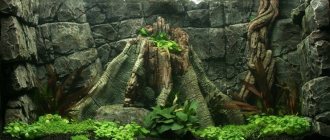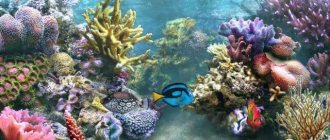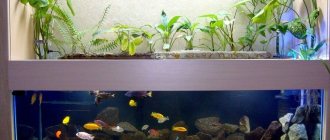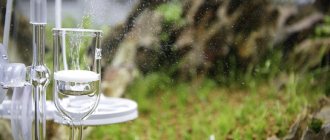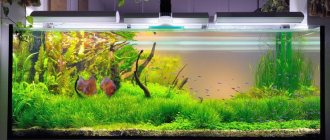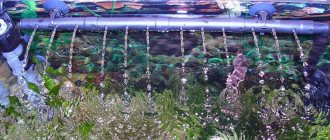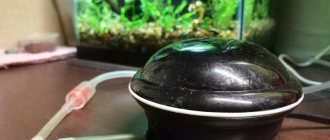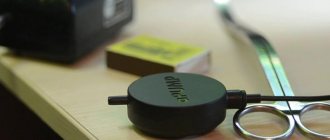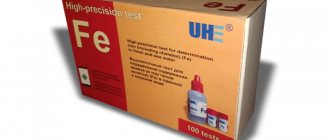I made a 3D background for my 546 liter aquarium. The process itself is quite simple, despite the fact that the process took a long time and left behind mountains of waste. Next time I’ll make the background myself again - it’s several times cheaper than a custom-made one.
In this article I will tell you how to make a background for an aquarium with your own hands. This background can be made for aquariums of any size. The materials used are safe for fish.
Attention: this volumetric aquarium backdrop can only be used in a freshwater environment.
Necessary tools for gluing the background to the back wall
To stick the film on the wall of the aquarium, you need to prepare several tools:
Glycerin solution
Decorative film
Several napkins
Stationery knife
Metal ruler
Silicone spatula
As an alternative for a spatula, you can consider an old bank or discount card. If you have a hard piece of cardboard in your home workshop, you can take that too.
Step by step instructions
To properly glue the aquarium background, you need to follow the step-by-step guide. This will allow you to decorate the structure in an even layer without bubbles or folds.
Film preparation
Before cutting the film, you should evaluate the size of the glass and cut the required piece. It is important to be especially careful at this stage, as an uneven cut will impair subsequent gluing. Cutting should be done using a utility knife and ruler. If you have no experience in performing such actions, you should practice on a small piece of film.
How to prepare glass for gluing film
The surface of the aquarium needs to be thoroughly cleaned before applying the film. If there are tiny contaminants on the glass, you will not be able to remove them after applying the layer.
It is better to clean glass with a special liquid and wipe it with microfiber.
Humidification of aquarium glass
To apply the material, you must first moisten the surface of the aquarium glass using a simple solution consisting of water and detergent (for example Fairy).
Such impregnation will facilitate the correct selection of a suitable position for the film and will quickly displace any air bubbles present.
Smoothing the film
The next step is to smooth the film to remove wrinkles and air bubbles. For these tasks, use a plastic card or ruler. It is better to move the bubbles from the central part of the film to the edges.
When applying the film, it is important to follow all stages sequentially and work carefully.
Trimming excess
At the finishing stage, you should check for traces of air or other defects on the decorative coating. The remainder of the film must be trimmed with a stationery knife.
How to choose a background for an aquarium
To select an aquarium background, you should choose a range of colors, type of design and style. The decorative coating should merge with the aquatic environment and complement it.
Color range
It is advisable to choose the paints used that are close to natural colors.
Among the popular colors in the aquarium hobby are the following shades:
- Black. It is distinguished by its brevity and versatility. It does not distract the viewer’s attention from the fish, underwater landscape and algae. In addition, black tones can visually expand the space and give it a natural look.
- Light blue, green, light green. The listed shades create a subconscious association with the abyss of the sea. Due to the low contrast, such a background will be a good addition to an aquarium containing brightly colored fish.
- Sandy, ocher, yellow and brown. Such tones imitate the topography of a lake or river, so they are common in freshwater aquariums.
If you want to make an aquarium on a white background, then it is better to place bright species of fish in it.
Background type
There are different types of aquarium backgrounds on sale, which differ in the installation method. The outer film is characterized by reliability and durability. In addition, such material will not come into contact with living beings and the aquatic environment. However, if you want to replace it, you will have some difficulties.
The film, which is fixed inside the tank, gives the structure a laconic and complete look. At the same time, it should not disrupt the natural life cycle of fish and pollute the water.
What else
When choosing a background for an aquarium, you should take into account its other characteristics, for example, the material of manufacture. In most cases, BOPP film is used, which is low cost and easy to install. It is usually done in the style of the underwater world or a freshwater landscape, including photographs of vegetation, fish or other marine organisms.
The subjects of background printing are varied, the materials are harmless to use.
Screens made from polyresin or ceramic components create an imitation of stonework, wood grain and roots. Caring for such a coating is quite simple, because... it is easy to clean with water. However, the material reduces the usable space of the tank.
Making your own backgrounds
For spare changeable backdrops, materials must be selected with a long service life.
You can make a stylish background for an aquarium tank with your own hands. To do this, you need to prepare available tools and materials, and also follow some instructions.
Replaceable
Making a replacement background for an aquarium.
If you like to experiment with aquarium background designs, it is better to form a replacement decor with a rigid base. You can use thin plywood or even cardboard as a backing. It is necessary to give it the shape of the back wall of an artificial reservoir.
The substrate is thoroughly wiped with a soft cloth and cleaned of the protective layer. To remove air bubbles, smooth the picture with a rubber spatula. Next, 2 cm of the protective layer is peeled off and the background is glued step by step. After fixing the film, it should be smoothed with a soft cloth. The procedure should be carried out as quickly as possible so that the applied glue does not dry out.
Decoration inside the back wall
Decorating the inner surface of the back wall of the aquarium is a painstaking and lengthy process. To make fish feel comfortable and live in beautiful conditions, you will need to spend a lot of time and effort. If you want to change the internal design of the aquarium, you need to remove all the contents. This will simplify the upcoming work and protect underwater inhabitants from negative influences.
Plants in the aquarium
Live vegetation is the best decoration for any aquarium, and also forms an irreplaceable part of the ecosystem of the aquatic environment. Algae absorb nutrients from soil and water, reduce carbon dioxide concentrations and promote the release of oxygen.
For vegetation, you can use Java moss, which floats freely in the water and is fixed to roots or stones. In addition, it does not require special care and is able to develop normally in low light conditions.
Java moss
Cryptocoryne Wendt
In aquarium conditions, you can grow Cryptocoryne Wendtu, which grows up to 30 cm in height and develops normally when there is a lack of light.
Foam background
To make a background based on foam plastic, you should adhere to the following algorithm of actions:
- You should not select even and smooth polystyrene foam - the more irregularities and angles there are on its surface, the better it will fit into the composition of the aquarium. The material will need to be broken into uneven pieces and joined with glue.
- The panel should be covered with tile adhesive in 2-3 layers, and when it dries, you can begin painting.
- To distribute paintwork materials, you should use a sponge.
- After drying, you should immerse it in water for 2 days and refresh it every 24 hours.
Advantages of different types of aquarium background
The background, which is fixed inside the tank, has several limitations. It must remain neutral to water and not take up space from underwater inhabitants. External modifications are safe for the aquatic environment and fish, since they do not come into contact with liquid. In addition, they have the following advantages:
- Availability.
- A variety of textures and designs.
- Easy installation.
- Space saving in small aquariums.
- Easy to update.
In addition, film materials are durable, because... they are outside the aquatic environment and are not subject to its destructive effects.
In the design you can use a combination of interior and exterior decoration.
Self-adhesives are easy to attach and are compatible with different types of aquarium tanks.
If a living background of plants is chosen, it will complement the composition of the marine environment and saturate the water with oxygen.
What kind of background is there?
There are 2 modifications of aquarium coatings:
- Internal. They create the maximum imitation of natural sea conditions, but require complex installation. Also, only non-toxic materials that do not pose a threat to the health and life of the fish can be used inside the tank. The background is installed in the aquarium before adding liquid and placing living creatures. An important requirement is that the decorative layer must be firmly fixed to the glass so that it does not fall off when interacting with water and underwater inhabitants.
- External. They are low cost and available in all pet stores. In addition, such materials are not subject to destruction by aquatic vegetation.
Self-adhesive film
You can apply a film for an aquarium at home without outside help, since this process is simplified. Such a surface is inexpensive and is available in different decoration options. The layer can be glued to the outside of the tank, and if desired, can be easily removed and updated. The self-adhesive background is suitable for small aquariums, since when decorating large structures it is difficult to complete the gluing without bubbles and folds.
Glass painting
If you want to decorate the back of the aquarium without buying a film, you can paint it using indelible paint and special stencils. Using blanks, the design is applied easily and painted in the desired color palette. If it is not possible to do this, it is enough to create a plain background using an aerosol can.
The drawn version looks three-dimensional and gives the tank additional authenticity.
Relief and 3D
The volumetric background implies the use of elastic and safe materials based on polymer components, which can be given any geometric shape and configuration. The relief version has a 3D effect, which has a positive effect on the harmony of the marine composition.
The disadvantages of the solution include:
- Inability to use in aquariums with a non-standard shape.
- The need for regular cleaning due to algae fouling and the accumulation of suspended matter.
- High cost.
- Reducing free space inside.
Living plants
With the help of living plants, you can create the maximum imitation of natural conditions for marine life. Aquarium algae can be supplemented with stones, models of sunken ships and other decorative items.
Backlit background
A luminous background for an aquarium is an interesting solution. You can make such a background yourself using an ice lamp or purchase a ready-made ADA Light Screen solution.
Matte background
Alternatively, you can use a matte background. At the same time, you can save money and buy a matte film for glass, windows or the bathroom.
Other methods of gluing film
In addition to the classic method of installing the film, it is also secured in the following ways:
- Overlapping.
- Scotch tape.
- Glue.
Application of overlapping film
This option is practically no different from the classic one, since the preparatory steps and principles of surface treatment look identical. In this case, you do not have to cut the film into strips and adjust it to the size of the tank. It can be pasted with a pass, and the remains can be cut off using a stationery knife.
On tape
You can attach the film to the aquarium with tape. To do this, you need to attach the background to the surface and secure it with adhesive tape.
On glue
Before spreading the adhesive mixture, clear the surface of air bubbles with a plastic card or a triangle ruler. It is important to carry out gluing as quickly as possible, since the composition dries quickly and loses its properties.
